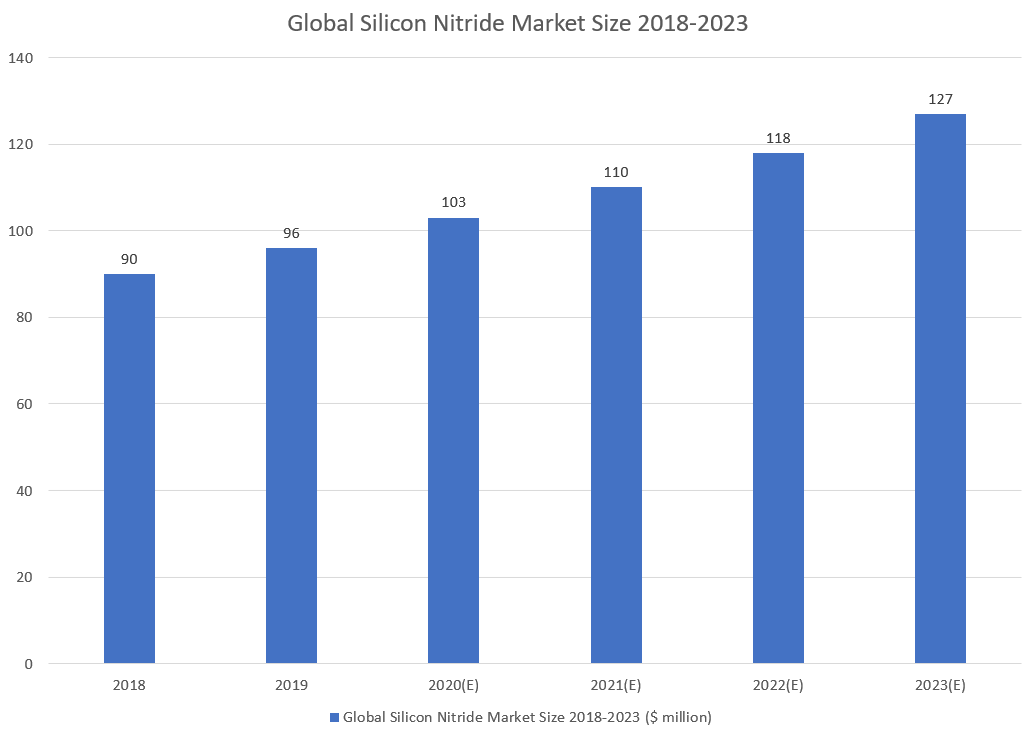Silicon Nitride Ceramic Overview
1.1 Definition
Silicon nitride is an inorganic substance with chemical formula Si3N4. It is an important structural ceramic material with high hardness, lubricity and abrasion resistance. It is an atomic crystal, with oxidation resistance at high temperature environment. And it has high thermal shock resistance, heating to more than 1000℃ in the air, rapid cooling then rapid heating again, it won't break. Because of such excellent properties, people often use Si3N4 to manufacture mechanical components such as bearings, turbine blades, mechanical sealing rings and permanent molds.
1.2 Properties
The special stable structure of silicon nitride brings many excellent properties, especially high strength, wear resistance, corrosion resistance, high temperature resistance, good oxidation resistance, theoretically high heat conductivity etc.
Material structure: Si3N4 has 3 crystalline structures: α、β 、γ.
α、β are the most common forms of Si3N4 and can be prepared under normal pressure. γ can be synthesized only at high pressure & temperature, the hardness can reach to 35GPa.

α、 β 、 γ.
Application effects: high bending strength and fracture toughness, high wear resistance and certain self-lubricating ability, excellent heat insulation ability. Therefore, it is used as material of bearings / electronic packaging substrate.
1.3 Preparation technology
Pressureless sintering
High purity, ultrafine, high α content of si3N4 powder mixed with small quantity of sintering aids, passing the process of forming, sintering etc.
Advantages: The ceramic can be complex shaped and with excellent performance.
Disadvantages: products are liable to crack and deformation.
Reactive sintering
After the forming of silicon powder (or the mixture of silicon powder with silicon nitride powder), the pre-nitride treatment is carried out with nitrogen at about 1200℃, and then the required parts are processed mechanically, and finally the nitride sintering is carried out at about 1400 ℃.
Advantages: no shrinkage, low cost, don't need to add sintering aids.
Disadvantages: Long nitriding time
Hot pressed sintering
The Si3N4 powder with a small quantity of additives were pressed and sintered at 19.6 MPa and 1600 ℃ conditions.
Advantages: Compared with reactive sintering, it has better ceramic performance and shorter manufacturing period.
Disadvantages: high cost, complex sintering equipment required, sintering shrinkage rat.
Gas pressure sintering
The Si3N4 was sintered in nitrogen (5-12mpa) at 1800-2100 ℃
Advantage: complex shape, suitable for mass production.
Disadvantages: High sintering temperature required.
1.4 Application Areas
Silicon nitride ceramics are widely used in aerospace & defense, mechanical engineering, auto, energy & environment, metallurgy & chemical industry due to the excellent high temperature resistance, corrosion resistance, abrasion resistance and insulation properties.
With the development of manufacturing processes and analytical techniques, the reliability of silicon nitride ceramics is constantly improved, so its applications are constantly expanding.
Wear resistance and high temperature resistance
Rotor stator and vortex tube used in gas turbine in ceramic engine; The spark plug of diesel engine, the top of piston hood, cylinder liner, auxiliary combustion chamber and components of aero engine, etc.
Good wear resistance, high hardness and strength, low friction coefficient
Machinery industry, eg: manufacturing bearings, ball, roller, ball seat ring, high temperature bolts, molds, plunger pumps, sealing materials, etc.
Good chemical stability
Prepare corrosion-resistant and wear-resistant components, such as ball valves, sealing rings, filters, heat exchanger parts, pipes, catalyst carriers, etc.
High resistivity, high thermal conductivity, etc
Apply to circuit substrates, thin film capacitors, high temperature insulators, radars, etc.
Silicon Nitride Ceramic Industry Chain Analyses
Upstream raw material: the chemicals SiCl4, SiO2, NH3 etc, sintering aids.
Midstream: Silicon nitride powder, silicon nitride ceramics
Downstream: Products like Silicon nitride ceramic ball, ceramic bearing, Ceramic heating sheet, Thermal conductive substrate, Cutting tools, wear-resisting tools etc.
Tips: Silicon nitride ceramic products are mainly used in aerospace & defense, automotive, electronic and electrical areas of temperature resistant / wear-resistant components.
Silicon Nitride Ceramic Market Analyses
From 2018-2023, the market size of silicon nitride grows from $90 million to $127 million (estimated), with an annual compound growth rate around 7.2%.
The Asia-Pacific will be the largest market for silicon nitride, therein China accounted for the largest share of the market, the following are Japan, South Korea and India.

Source: MARKETS AND MARKETS
Silicon Nitride Growing Trend
Silicon nitride ceramic substrate will become the future market trend
Compared with other ceramic materials, si3N4 has obvious advantages, especially in high-temperature resistance, chemical inertia to metal, ultra-high hardness, fracture toughness and other mechanical properties. This will make si3N4 ceramic PCB substrate an attractive substrate for high strength thermal conductive electronic devices.
As an interventional material for medical implant, it has gradually become an important research field.
• Si3N4 has good biocompatibility, especially partial ray transmittance and the visibility of radiographic tablets, and it has no cytotoxicity, so it has a very good medical application prospect.
• Improving the toughness and processability of si3N4 ceramics by introducing β while maintaining good biological properties is the current development trend of si3N4 ceramics as biomedical materials.
Porous silicon nitride ceramics are likely to be used in aerospace & defense industry
Porous silicon nitride ceramics have great potential in the application of space wave-transmitting materials due to their excellent mechanical properties, broadband transmissibility and stability. They are supposed to be the most promising radome materials, and will play an important role in the upgrading of military equipment.
声明:本文由 CERADIR 先进陶瓷在线平台的入驻企业/个人提供或自网络获取,文章内容仅代表作者本人,不代表本网站及 CERADIR 立场,本站不对文章内容真实性、准确性等负责,尤其不对文中产品有关功能性、效果等提供担保。本站提醒读者,文章仅供学习参考,不构成任何投资及应用建议。如需转载,请联系原作者。如涉及作品内容、版权和其它问题,请与我们联系,我们将在第一时间处理!本站拥有对此声明的最终解释权。












